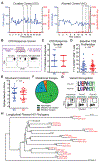Functional impairment of HIV-specific CD8+ T cells precedes aborted spontaneous control of viremia
- PMID: 34496223
- PMCID: PMC8516715
- DOI: 10.1016/j.immuni.2021.08.007
Functional impairment of HIV-specific CD8+ T cells precedes aborted spontaneous control of viremia
Abstract
Spontaneous control of HIV infection has been repeatedly linked to antiviral CD8+ T cells but is not always permanent. To address mechanisms of durable and aborted control of viremia, we evaluated immunologic and virologic parameters longitudinally among 34 HIV-infected subjects with differential outcomes. Despite sustained recognition of autologous virus, HIV-specific proliferative and cytolytic T cell effector functions became selectively and intrinsically impaired prior to aborted control. Longitudinal transcriptomic profiling of functionally impaired HIV-specific CD8+ T cells revealed altered expression of genes related to activation, cytokine-mediated signaling, and cell cycle regulation, including increased expression of the antiproliferative transcription factor KLF2 but not of genes associated with canonical exhaustion. Lymphoid HIV-specific CD8+ T cells also exhibited poor functionality during aborted control relative to durable control. Our results identify selective functional impairment of HIV-specific CD8+ T cells as prognostic of impending aborted HIV control, with implications for clinical monitoring and immunotherapeutic strategies.
Keywords: CD8(+) T cell dysfunction; HIV control; human immunology.
Copyright © 2021 Elsevier Inc. All rights reserved.
Conflict of interest statement
Declaration of interests The authors declare no competing interests.
Figures






References
-
- Allen TM, Altfeld M, Geer SC, Kalife ET, Moore C, O’Sullivan K M, Desouza I, Feeney ME, Eldridge RL, Maier EL, et al. (2005). Selective escape from CD8+ T-cell responses represents a major driving force of human immunodeficiency virus type 1 (HIV-1) sequence diversity and reveals constraints on HIV-1 evolution. J Virol 79, 13239–13249. 10.1128/JVI.79.21.13239-13249.2005. - DOI - PMC - PubMed
Publication types
MeSH terms
Grants and funding
- DP2 AI154421/AI/NIAID NIH HHS/United States
- K24 AI155233/AI/NIAID NIH HHS/United States
- U19 AI096109/AI/NIAID NIH HHS/United States
- T32 AI060530/AI/NIAID NIH HHS/United States
- R01 AI152979/AI/NIAID NIH HHS/United States
- UM1 AI126611/AI/NIAID NIH HHS/United States
- P30 AI027763/AI/NIAID NIH HHS/United States
- L30 AI126472/AI/NIAID NIH HHS/United States
- K23 AI157875/AI/NIAID NIH HHS/United States
- R37 AI155171/AI/NIAID NIH HHS/United States
- R01 AI118544/AI/NIAID NIH HHS/United States
- R01 HL134539/HL/NHLBI NIH HHS/United States
- R24 AI067039/AI/NIAID NIH HHS/United States
- R01 AI149704/AI/NIAID NIH HHS/United States
- R01 AI130005/AI/NIAID NIH HHS/United States
- L30 AI147159/AI/NIAID NIH HHS/United States
- P30 AI060354/AI/NIAID NIH HHS/United States
LinkOut - more resources
Full Text Sources
Medical
Molecular Biology Databases
Research Materials

